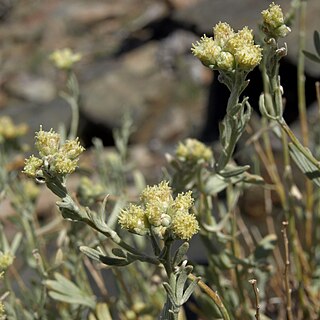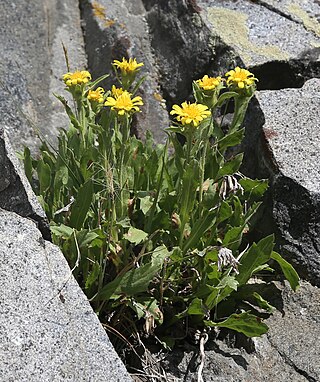
Stenotus is a genus of flowering plants in the family Asteraceae. There are four species, all native to western North America. They are known commonly as mock goldenweeds.

Pyrrocoma apargioides is a species of flowering plant in the family Asteraceae known by the common name alpineflames. It is native to the western United States from the Sierra Nevada of California east to Utah, where it grows in the forests and meadows of high mountains. It is a perennial herb growing from a taproot and producing one or more stems to 30 centimeters in length. The stems are decumbent or upright, reddish, and hairless to slightly woolly. Most of the leaves are located around the base. They are thick and leathery, lance-shaped with large sawteeth along the edges, often center-striped in white, and measure up to 10 centimeters long. The inflorescence is usually a single flower head lined with centimeter-long phyllaries which are reddish to green with red edges. The head has a center of yellow disc florets and a fringe of ray florets which are yellow, often splashed with red along the undersides, measuring up to 1.6 centimeters in length. The fruit is an achene which may be well over a centimeter in length including its pappus.

Raillardella argentea is a species of flowering plant in the family Asteraceae known by the common name silky raillardella. It is native to the Sierra Nevada and nearby mountain ranges of California, its distribution extending east into Nevada and north along the Cascade Range and Klamath Mountains into Oregon. It grows in many types of dry, open mountain habitat. It is a rhizomatous perennial herb growing in a clump of rosetted basal leaves. The leaves are lance-shaped, up to 8 centimeters long, and coated in silky hairs. The plant produces an inflorescence up to about 15 centimeters tall consisting of a solitary flower head which is cylindrical to somewhat bell-shaped. The head is enclosed in the fused outer scales of the flowers, which look similar to the phyllaries of many other species' flower heads. The head contains many yellow disc florets up to a centimeter long each, and no ray florets. The fruit is a long, narrow achene which may be 2 centimeters in length including its plumelike pappus.

Rudbeckia californica is a species of flowering plant in the family Asteraceae, known by the common name California coneflower.

Sanvitalia abertii is a species of flowering plant in the family Asteraceae known by the common names Abert's creeping zinnia and Abert's sanvitalia. It is native to the southwestern United States and northern Mexico, where it grows in desert scrub, desert mountains and woodlands. It is an annual herb somewhat variable in appearance. The mainly erect stem may be 2 to 29 centimeters tall, and simple or with many branches. The linear or lance-shaped leaves are a few centimeters long. The plant is coated in rough hairs. The inflorescence is a cyme of flower heads with thick, leathery yellow ray florets 2 or 3 millimeters long and notched at the tips. The fruit is an achene. Achenes arising from the ray florets are light-colored and tipped with pappi, while those from the disc florets at the center of the flower head are darker and lack pappi.
Packera macounii is a species of flowering plant in the aster family known by the common name Siskiyou Mountains ragwort. It is native to the west coast of North America from British Columbia to far northern California, where it grows in chaparral and mountain forests, often on serpentine soils.

Senecio sylvaticus is a species of flowering plant in the aster family. It is variously known as the woodland ragwort, heath groundsel, or mountain common groundsel. It is native to Eurasia, and it can be found in other places, including western and eastern sections of North America, as an introduced species and an occasional roadside weed. It grows best in cool, wet areas. It is an annual herb producing a single erect stem up to 80 centimeters tall from a taproot. It is coated in short, curly hairs. The toothed, deeply lobed leaves are up to 12 centimeters long and borne on petioles. They are evenly distributed along the stem. The inflorescence is a wide, spreading array of many flower heads, each lined with green- or black-tipped phyllaries. The heads contain yellow disc florets and most have very tiny yellow ray florets as well.

Sphaeromeria cana is a species of flowering plant in the family Asteraceae known by the common name gray chickensage. It is native to the western United States, where it is known from the Sierra Nevada, the adjacent desert ranges of eastern California and Nevada, and Steens Mountain of Oregon. It grows in dry, rocky mountain habitat, such as cracks and crevices, including the talus above the tree line. This is an aromatic subshrub with numerous erect branches growing up to 30 to 60 centimeters tall. It is gray-green in color and coated with woolly fibers. The leaves are linear or lance-shaped, the lower ones divided into lobes. The inflorescence is generally a cluster of flower heads lined with woolly phyllaries and containing yellow disc florets. There are no ray florets. The fruit is a ribbed achene about 2 millimeters long.

Stenotus acaulis is a species of flowering plant in the family Asteraceae known by the common name stemless mock goldenweed.

Stenotus lanuginosus is a species of flowering plant in the family Asteraceae known by the common names woolly mock goldenweed and woolly stenotus.
Tonestus eximius is a species of flowering plant in the family Asteraceae known by the common names Lake Tahoe serpentweed and Tahoe tonestus. It is native to the High Sierra Nevada, where it is known only from the vicinity of Lake Tahoe on the California-Nevada border. It grows in alpine and subalpine mountain habitat. It is a short, clumpy perennial herb growing up to 13 centimeters tall. The thick stems are hairless and glandular, the lower parts covered in the withered leaf bases of previous seasons' growth. The toothed or serrated leaf blades are up to 3 to 5 centimeters in length. The inflorescence is a single flower head or a cluster of a few heads. Each is 1 to 1.5 centimeters wide with green phyllaries. The head bears at least 10 bright yellow ray florets around a center containing many tubular disc florets.

Tonestus peirsonii is a local-endemic species of flowering plant in the aster family known by the common names Inyo tonestus, Peirson's serpentweed and Peirson's tonestus.

Townsendia condensata is a species of flowering plant in the family Asteraceae known by the common names cushion Townsend daisy and cushion townsendia. It is native to North America where it is known from many scattered occurrences in the mountains of the western United States and Alberta in Canada. It is mainly limited to the alpine climates of high mountain peaks, where it grows in meadows, tundra, and barren, rocky talus. It grows alongside other alpine plants such as Eriogonum androsaceum.

Townsendia leptotes is a species of flowering plant in the family Asteraceae known by the common names common Townsend daisy and slender townsendia. It is native to the western United States, where it grows in the alpine climates of high mountain ranges from California to Montana to New Mexico.

Townsendia scapigera is a species of flowering plant in the family Asteraceae known by the common name tufted Townsend daisy. It is native to the western United States, where it grows in mountains, sagebrush, and other habitat.
Eurybia horrida is a species of flowering plant in the family Asteraceae known by the common names spiny aster and horrid herrickia. It is native to Colorado and New Mexico in the United States, where it occurs only in the Canadian River basin. It most often included in genus Eurybia.

Calochortus lyallii, or Lyall's mariposa lily, is a North American species of flowering plant in the lily family. It is native and endemic to Province of British Columbia in western Canada, as well as the State of Washington in the northwestern United States. It only grows east of the Cascade crest in the mountains and foothills, and though its numbers are apparently secure in Washington, it is considered to be a blue-listed species in Canada- blue-listed taxa are at risk, but are not extirpated, endangered or threatened. It is found in dry to mesic open forest at lower to middle elevations in the mountains, commonly found with Pinus ponderosa, Pseudotsuga menziesii, Calamagrostis rubescens (pinegrass) and Carex geyeri.

Eurybia glauca is a North American species of flowering plants in the family Asteraceae, called the gray aster. It is native to the western United States, primarily in Arizona, New Mexico, Utah, Colorado, and Wyoming, with a few populations in Idaho and Montana.

Eurybia kingii is a North American species of flowering plants in the family Asteraceae, called the King's serpentweed or King's aster. It has been found only in the State of Utah in the western United States.
Eurybia wasatchensis is a North American species of flowering plants in the family Asteraceae, called the Wasatch aster. It has been found only in the state of Utah in the western United States.
















